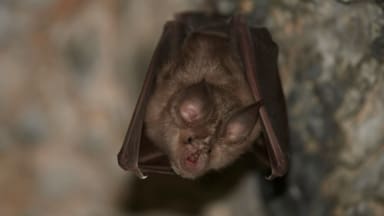
Bats are a vital part of our native wildlife, accounting for almost a third of all mammal species in the UK and occupy a wide range of habitats, such as wetlands, woodlands, farmland, as well as urban areas. As ‘indicator species’, bats can tell us about the state of the environment. Being top predators of common nocturnal insects, they are sensitive to changes in land use practices. Any pressure they face – such as landscape change, agricultural intensification, development, and habitat fragmentation are relevant to many other wildlife species, making them excellent indicators for the wider health of the UK’s wildlife.
Over 70% of all bat species feed on insects and as such play an important role in controlling insect numbers. All bats in the UK are insectivores, helping to regulate insect numbers on farms and gardens. While bats can provide a valuable service for agriculture, increased use of pesticides may mean that bats go hungry from the lack of insect prey. The destruction of hedgerows and woods in farmland is also concerning, as bats rely on these features for roosting, hunting and getting around.
Many people are unaware that over 500 plant species rely on bats to pollinate their flowers, including species of mango, banana, durian, guava and agave. Pollination of plants by bats is called chiropterophily, the flowers for which tend to have pale nocturnal flowers. The flowers are often large and bell shaped, for which the bats have evolved specifically to reach the nectar at the bottom of them.
Around the world there is a huge diversity of bats, with the UK’s 17 resident types of bat accounting for a quarter of our native mammal species. Despite this incredible biodiversity, bat populations have seen a rapid decline over the last century due to human activity, including building work, the loss of roosting sites and the decrease of suitable habitats.
Support bats
The Bat Conservation Trust (BCT) is working to create a world where bats and people thrive together. They have launched the ‘Bats and beyond: supporting the next generation’ fundraising campaign to raise a minimum of £20,000 for scientific research. The campaign (18th – 25th of April) has been chosen by the Big Give for their Green Match Fund campaign which means that every donation up to £10,000 is doubled.
For details to support and donate, see the BCT website.
Helping bats in gardens
To help bats thrive in gardens, CJ Wildlife has shared some advice:
- Create bat home: Bat boxes are important for a number of different reasons. They reduce bat-human interaction, allowing these mammals to remain as ‘wild’ as possible. They also give females a safe space to safely raise and feed their young, and provide a warm and secure place for bats to roost during the day in the summer. When choosing a box it is important to pick materials that allow bats to grip onto and keep predators out. In many ways, a well-used bat box is often governed by the same rules as a desirable human home – location, location, location. CJ Wildlife recommend siting your bat box in a sturdy tree or building where bats have been seen or are known to feed. They suggest that a sheltered south or southwest spot is best, to ensure that the box is exposed to direct sunlight throughout the day. Lastly, if it is possible, putting a bat box near a wet area, such as a pond or marshy environment, will attract insects favoured by bats and will also provide them with somewhere to drink.
- Bat haven gardens: The 15 million gardens and 27 million gardeners across the UK, can help combat natural reduced habitat by creating a network of gardens to provide green corridors for bats and many other species. Planting night-scented flowers, such as evening primrose and honeysuckle, will encourage nocturnal visitors like moths, which will in turn provide a tasty treat for local bats. Inclusion of a pond provides a water source for bats, but will also encourage other aquatic creatures too. Ponds are a fantastic home for midges and aquatic larvae, which are favourites of the pipistrelle bat. Leaving patches of ground – or perhaps even the whole garden – go a little wild, providing a home for more insects, larvae and wildlife, including bats. Wildflowers attract a whole host of creatures which can help to sustain bat populations. Compost heaps provide a home for insects and hence for bats. Established trees and shrubs provide shelter for insects that can use them to lay eggs and reproduce, attracting even more bugs for bats to feast on. Retain mature trees wherever possible, as bats can use handy hollows to roost in.
- Inspire the next generation: Get children involved and stimulate curiosity in the natural world by giving them a unique project, such as building their own bat boxes to help the wildlife around them.

